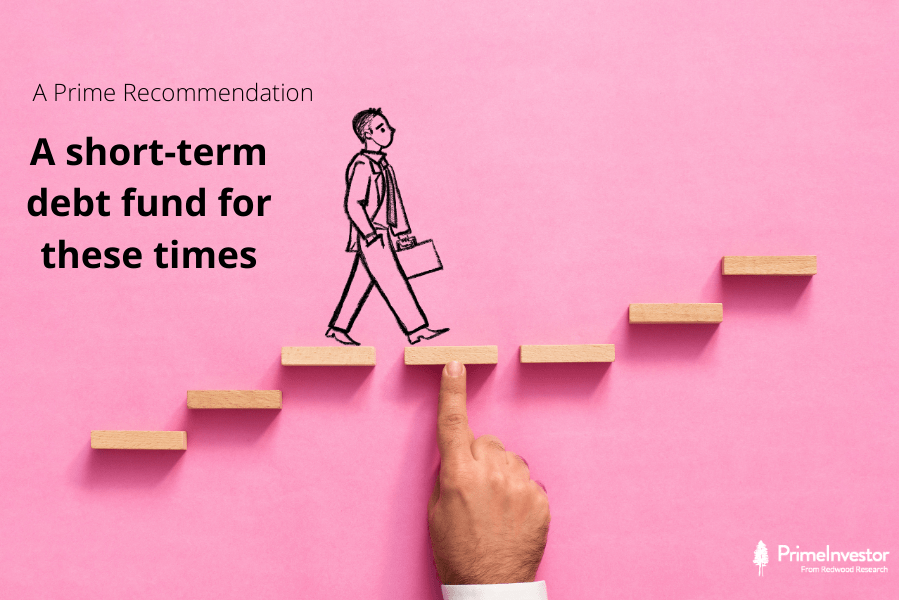Two events have set the stage for a rise in yields, whether the RBI pauses or hikes rates. One, a few weeks ago, the RBI closed the tap that pumped liquidity into the system. That meant no more excess supply of money. This caused an immediate rise in short-term yields, causing mark-to-market losses in some funds over a week or two. In just 2 months, the 3-month government bond moved from 2.9% in December beginning to 3.36% now. This is a sharp move for a shorter tenure bond.
Two, Budget 2021 has decided to retain its market borrowing at Rs 12 lakh crore, same as the pandemic-hit year. It has also provided many novel measures to tap the debt market for infrastructure financing. The 10-year gilt yields climbed sharply as the budget was announced.

We think that the duration gain that longer duration strategies gave is coming to an end. We had proposed a short duration strategy in our 2021 Debt Outlook. Over the next few months, we will cover in detail the short duration funds that we already have in our Prime Funds list, so that you are aware of your choices.
But what about those of you who are holding longer duration funds? Do you sell your longer duration funds and move to a shorter duration? The answer is NO. We’ll explain why at the end of this article.
The fund we’re picking today, to play the shorter duration accrual strategy is HDFC Short Term Debt. This fund has long been a part of Prime Funds.
The fund & suitability
HDFC Short Term Debt is a predominantly accrual-based strategy with some lever to use duration to push returns. Its average portfolio maturity has not exceeded 3.75 years thus far. It is ideal for those with time frame of 2 years and above (no limit on the maximum timeframe needed).
It has less than 10% exposure to papers below AA+. To put this in perspective, if you take the short duration and banking & PSU debt category (which we classify together for our analysis given that they need the same holding period), the average holding in papers below AA+ is 3.5%. Hence, you should be willing to take this above-category average risk (discussed more later) for some additional returns.
Performance
HDFC Short Term Debt stands out for its performance, when compared to different categories of funds.
- The fund has beaten the short duration category average 94% of the times based on rolling 1-year return, rolled daily, for 3 years – making it the best in category in terms of consistency.
- If you take a larger universe of short duration and banking & PSU debt funds, it excels still – with a 98% outperformance. Only Axis Short Term matches this consistency.
- For many of you thrilled by the high returns in the floater funds category – a comparison there too shows that the fund’s average 1-year returns (for 3 years of daily rolled periods) was 8.7% compared with an average 7.9% for floater funds with 3 years of data.
- It even keeps pace with HDFC Corporate Bond, which gains more with higher duration. Average 1-year return of 8.7% is not too far from HDFC Corporate Bond’s return of 8.8%!
Portfolio Fit
That’s a bunch of comparisons. So how do you fit this fund in your portfolio? Here’s how to decide:
- If you are risk averse: banking & PSU debt funds of less than 3-year duration and corporate bond funds for over 3-year duration would fit you better.
- If you prefer less volatility and have a time frame of 1-2 years, then the floater funds we recommend would be a better fit. Their volatility (barring the ones with high duration) over 1-month time frames is far lesser than HDFC Short Term Debt.
- If your requirement is higher return for marginally high risk (we call it taking calculated risk), then this fund will fit you.
- If you have a large corpus and add this fund, consider holding a banking & PSU along with it to diversify. If you have a longer time frame, then add it along with a corporate bond fund. If your question is whether you can hold all 3 – you can!
- If you hold other funds from our recommended list and chose them based on your time frame, there is really no need to switch to this fund! Please note this point well 😊 Only if you are looking for diversification or fresh allocation should you consider adding HDFC Short Term Debt. Don’t make a move just because your long-duration fund is suddenly falling now. Please read the section at the end of this article.
Portfolio makeup
HDFC Short Term Debt has been adept in changing its duration within a limited range to provide superior gains to its peers. The chart below will show you how it upped its average maturity to ensure it participated a bit in the rate fall that began from 2019. This appears to be the primary reason for its above-category average returns.
Now, since August, it has been very gradually reducing its maturity to ready itself for a rate hike scenario. It still could not escape the hit in the past 1 month that generated negative returns across many categories. However, going forward, we do expect the fund to bring down maturity and generate accrual. Up until such time, some volatility should be expected.
HDFC Short Term Debt holds over 150 securities and is well-diversified across groups. Government securities, instruments from HDFC, REC, SBI and the Tata group account for over 5% each of its holdings. So, there is little concentration risk.
However, the fund has 8.4% in papers below AA+. A majority of this comes from 3 heads – Tata group companies (3.9%), Vedanta group (2.3%) and perpetual bonds of public sector bonds (but this is low at only 1.2%). The rest comes as micro holdings in names such as Hindalco, Shriram and Mannapuram to name a few.
In other words, the risk too is not concentrated. Of this, our concern at this juncture remains the Vedanta group. However, the proportion held allows us to take the risk, in the absence of any severe redemption pressure. The fund’s size at Rs 17,900 crore also provides the leeway.
This small risk with active duration (within limited range) helps the fund deliver marginally higher returns than the category. Do note that the fund does have a history of dealing with some defaults (Hazaribagh Ranchi Expressway of the IL&FS group) without taking much a hit, because of its well-diversified portfolio.
The fund is managed by Anil Bamboli since its inception in June 2010.
Should you switch your longer duration investment to shorter duration?
We have been receiving queries on whether you should switch from your corporate bond or constant maturity funds to shorter duration funds as most of the duration funds sport 1-month losses of around 0.5%. The answer is NO.
When we provide a strategy, it is to play ‘point in time’ – meaning if you were to deploy additional surplus in the best possible channel now, what that would be. At this juncture, that option would be shorter duration.
However, this does not mean you should disturb or switch your longer duration funds (meant obviously for longer duration). Such a strategy results in 2 things: one, you would lose out on the likely marginally higher returns that longer tenure funds would give you with time. Two, you would unnecessarily incur taxes.
Trust us, the extra returns from accrual compared with the poor returns you will see in all your longer duration funds will be temporary. We have, through many articles, explained to you (one here) that there will be losses when rate cycles turn upward in duration funds. That will start playing out now. It is normal and is not cause for panic. You do not need to act.
If you have fresh money to invest or have some money sitting on the sidelines because rates were low – start deploying. You can do it now or in phases. It does not matter.
If you are choosing our long-term portfolios with corporate bond or constant maturity funds – please invest. Be patient for it to work over 5 years or as stated there. If you cannot take the volatility, then always stick to shorter duration – lower return or not. Keep it simple, either way!







26 thoughts on “Prime Recommendation: A debt fund for the new rate scenario”
HI Vidya,
Thanks for nice article on HDFC Short term debt fund and calling out as Calculated Risk.
This fund holds the AT1/AT2 bonds and how will this impact the NAV going forward – I am not assuming the AT bonds are going to default, but NAV due to duration reclassification as mandated by SEBI? Should we continue to hold this fund or move to Short term funds without AT exposure like IDFC.
Exposure is not high enough to impact even if anything happens. But as we said, it takes marginally higher risk than peers. Vidya
Hello Vidya
Not sure if my question is right for this article..nevertheless i will ask : there is a growing concern globally about the rising debt and a fallout of a taper tantrum like what happened in 2013.. Although central banks have vouched not to effect policy changes, what options would they have to tame a rising inflation at some point.. If such an event were to happen, what effects would we have in the equity and debt market in India and emerging economies.. What should investors look out for and act..Would the FIIs pull money out of India and cause a crash in equity..would they also pull money out from the debt markets.. my questions may be naive but it will help if you can dedicate an article covering this topic.
Earlys tages of inflation usually benefit equity as it provides pricing power to sellers even as demand remains robust. Rates hikes (triggered by inflation) benefit debt investments. FII flow is dependent on relative factors and not just to do with our inflation alone. Rupee depreciation plays a large role. When this can be related to something more actionable (which our subscribers prefer :-)) we will definitely write. thanks for suggesting. thanks, Vidya
can you please let me know what is the purpose of moneymarket fund, in terms of debt asset allocation. Please guide me to the article if it already discussed.
Please read this article – it will cover your question and more on debt: https://www.primeinvestor.in/what-is-accrual-strategy-in-debt/ It will make it complete if you read more about debt here: https://www.primeinvestor.in/a-duration-strategy-in-debt-funds-explained/ thanks, Vidya
I echo the comments by Sudheesh. While I do appreciate the fund recommendation, these articles are also very educational and should foster better financial thinking (especially those who have been challenged in financial thought process likes yours truly :d)
Much appreciated. Keep them coming.
Thank you sir! Vidya
Thank you Vidya for the clear and concise advice. Very rarely available from websites actually. I want to ask, does this also mean that if you have some funds to deploy and don’t need it for the next 5-7 years and then you should invest in constant duration funds and they would have lower NAVs now?
In general, it is good to mix short and long duration funds for long term goals. However, where you want to keep portfolio compact, it is perfetly fine to invest in constant maturity. It will fall without any doubt …but definitely move to ‘normal’ in 5-7 years. thanks Vidya
Hi, I have purchased a house under the 10:5:85 scheme… where in 85 percent of the corpus is to be paid on possession which should happen around october 2022. I need to accumulate significant amount till then which need to be kept safe. Could you suggest funds wherein I can keep doing lumpsum investment till that time or can you help me with a strategy. I have already collected 50% corpus which is invested in Axis treasury adv, Axis Short term and Birla Floating rate fund.
Awaiting response from your end..
Hello Sir, The blog is usually meant for general comments and views on the article. We have responded. If you have specific questions on recommendations please write to us at [email protected]. Also, please note that we are not allowed to provide ‘planning/review’ services ne-on-one as they come udner advisory. thanks, Vidya
We do not provide ‘advice’ as you may be aware that we ae not a advisory service. However, from what you say, FD are the safest bet for your remainign 50% given the short time frame thanks, Vidya
Thanks Vidya for another lucid write up. More than the recommendation of HDFC short term fund, which incidentally I already have, I liked the clear and firm way (almost like a school teacher😀) in which you have advised on what we should do with the current investments. Much appreciated. Please continue advising / guiding on Debt Funds.
Good day…
Thanks sir 🙏 School teacher😀 What to do, sometimes forced to be one going by the variety of queries we get! 🙂 regards, Vidya
Which is a better overall strategy for a fixed income/debt portfolio for long term goals (7 years and more) ?
Do you suggest any improvements in below strategy considering the timeframe and current scenario?
a)Money market fund – 50% . Objective is to use it for rebalancing when equity markets fall
b) Medium duration fund -50%. Objective is to earn extra from duration strategy without Credit risk.
Hello, The allocation would you based on your time frame and return expectation. So I really don’t have a say. Some mix of short and medium duration is always good as the short lends liquidity for emergencies or for equity deployment. thanks, Vidya
Thank you for reply. I have mentioned timeframe as 7 years and return expectation is Moderate for debt category (6% post tax).
Khushboo, you have to appreciate that we are not financial planners and should not have a say in your allocation, regualtorily. That is why I said it is based on your time time and expectation. I have provided by broad view on whether your allocation is logical. thanks, Vidya
Vidya, Please consider that the question asked was not very specific, personal and it was in general strategy based for a longer time frame. I was expecting different Pros and Cons in general w.r.t. any better strategy. Anyways I appreciate your constraints and also your commitment. Thanks.
Khushboo, I Undertand. Any allocation question from an individual is specific as far as we are concerned, and we need to ensure we are within our ambit. Our primary job as analysts is to provide product recommendations. We provide portfolios etc giving samples of allocation for investors to understand and customise. We provide broad strategies. That’s the best we can do, within regulations. thanks, Vidya
The only question which I have is (after reading this “We have been receiving queries on whether you should switch from your corporate bond or constant maturity funds to shorter duration funds as most of the duration funds sport 1-month losses of around 0.5%. The answer is NO”) is ……I have done the investments in corporate bond and constant maturity funds in lumpsum, and there can be no more addition feasible in them, to take advantage of the current dip)…so, the question is – with lumpsums already done, will the target returns, or near about show up, in time? Thx
Yes, it will if you wait out the rate cycle. SIPs don’t mke a significant difference in debt funds. thanks, Vidya
Thank you …as always, the reply was prompt. How do you compare Axis Short term fund Vs HDFC short term fund ? …….I have both and fully invested …
You can check our review tool for our comments as both have a buy. Axis has slightly more 1-month negative instances but far more credit worthy. HDFC scores on risk-adjusted return given higher coupons of its marginally higher risk papers. thanks, Vidya
Comments are closed.